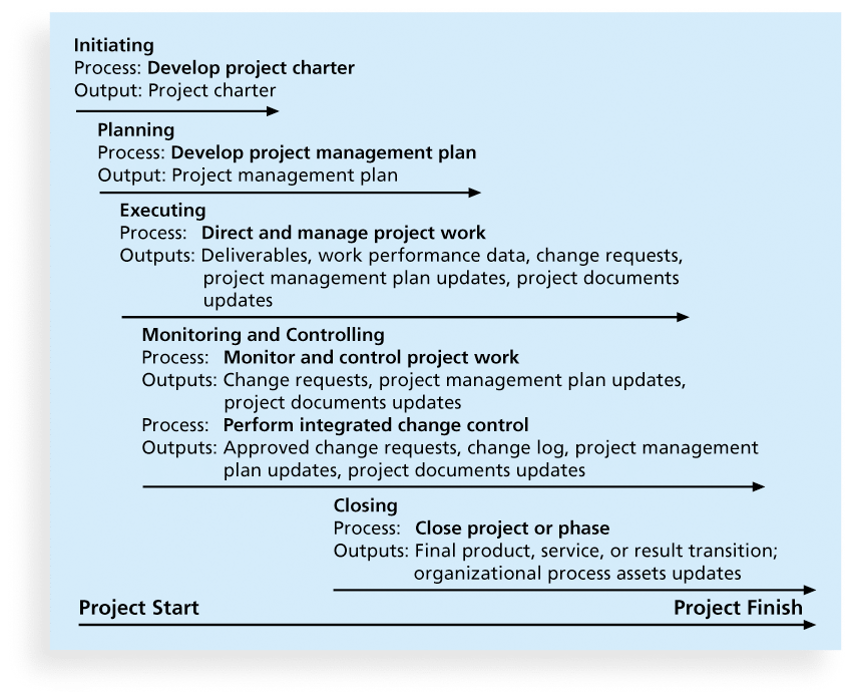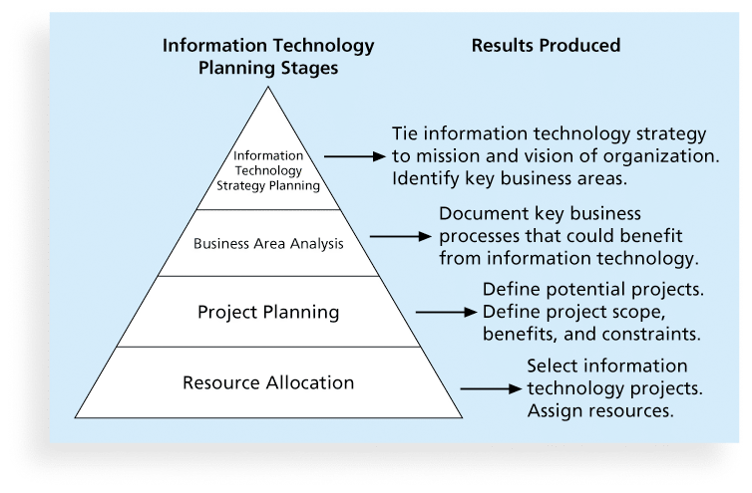Project Integration Management Back
1. Processes

- Developing the project charter(憲章)
- a document that formally recognizes(承認) the existence of a project and provides direction(指導) on the project's objectives and management.
- you should have the follow things as input:
- a project statement of work
- a business case
- agreements
- enterprise environmental factors
- organizational process assets
- Developing the project management plan.
- Common elements:
- introduction or overview of the project
- description of how the project is organized
- management and technical processes used on the project
- work to be done, schedule and budget information
- Common elements:
- Directing and managing project work.
- Execution tools:
- Expert judgment
- Meetings
- Project management information systems
- Execution tools:
- Monitoring and controlling project work.
- Collecting measuring
- Disseminating(宣傳)
- Performing integrated change control
- 3 main objectives:
- Influencing the factors that create changes to ensure that changes are beneficial
- Determining that a change has occured
- Managing actual changes as they occur
- Change control:
- a Change Control System describes when and how offical project documents and work may be changed and describes who is authorized to make changes and how to make it.
- a Change Control Bord(CCB) is a formal group of people responsible for approving or rejecting changes on a project.
- Making timely(及時的) changes:
- 48-hour policy
- 3 main objectives:
- Closing the project or phase
2. SWOT analysis
- Strengths(優勢)
- Weaknesses(劣勢)
- Opportunities(機遇)
- Threats(威脅)
3. Planning Stages

- Methods for selecting projects:
- focusing on board organizational needs.
- 3 criterias:
- there is a need for the project
- there are funds(儲備) available
- there is a strong will to make it succeed
- 3 criterias:
- categorizing(分類) information technology projects.
- focus on addressing:
- a problem
- an opportunity
- a directive(指令)
- focus on time
- how long it takes
- when it's needed
- focus on the priority
- focus on addressing:
- performing net present value or other financial analysis.
- Net Present Value(NPV) analysis
- 淨現值
NPV = Benifits - Costs
- Return on Investment(ROI) analysis
- 投資回報率
ROI = (Benifits - Costs) / Costs
- Payback analysis
- 回本
- Payback Period: the amount of time to recoup(收回)

- Net Present Value(NPV) analysis
- using a weighted scoring model

- focusing on board organizational needs.
4. Q&A
- What stage of information technology planning outlines business processes that are central to achieving strategic goals and helps determine which ones could most benefit from information technology?
- project planning
- business area analysis
- resource allocation
- information technology strategy planning
answer: business area analysis.
- In what stage of selecting information technology projects, organizations select information technology projects?
- project planning
- business area analysis
- resource allocation
- information technology strategy planning
answer: resource allocation.
- Which of the following is true of return on investment or ROI?
- It is always a percentage.
- It is the result of adding the project costs to the profits.
- It is always a positive number.
- The lower it is, the better.
answer: It is always a percentage.
- A project's internal rate of return can be determined by finding what discount rate results in an NPV of _ for the project?
- zero
- a hundred percent
- one
- fifty percent
answer: zero.
- Which is a document that recognizes the existence of a project and provides direction on the project's objectives and management?
- stakeholder register
- directive
- risk register
- project charter
answer: project charter.
- The business case includes information on what?
- the business need for the project
- the project objective, high-level requirements, and time and cost goals
- relevant government or industry standards
- policies, procedures, guidelines, and systems that influence a project's success
answer: the project objective, high-level requirements, and time and cost goals.
- Which of the following is a proactive process undertaken to reduce the probability of negative consequences associated with project risks?
- Performance reports
- Defect repairs
- Preventive actions
- Corrective actions
answer: Preventive actions.
- An IT company revises its process parameters in response to complaints from vendors that products were not ready on time. This would be an example of what?
- cost forecasting
- defect repairs
- a preventive action
- a corrective action
answer: a corrective action.
- What involves identifying and controlling the functional and physical design characteristics of products and their support documentation, and ensures that the descriptions of the project's products are correct and complete.
- NPV analysis
- Configuration management
- Project management information systems
- Project time management
answer: Configuration management.